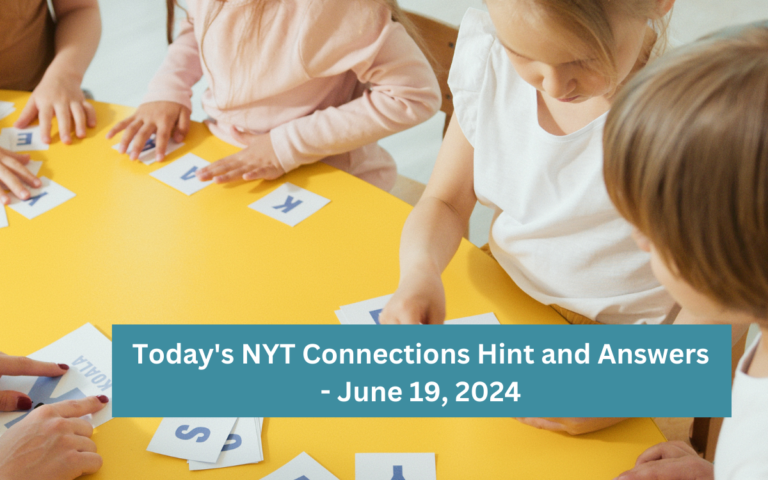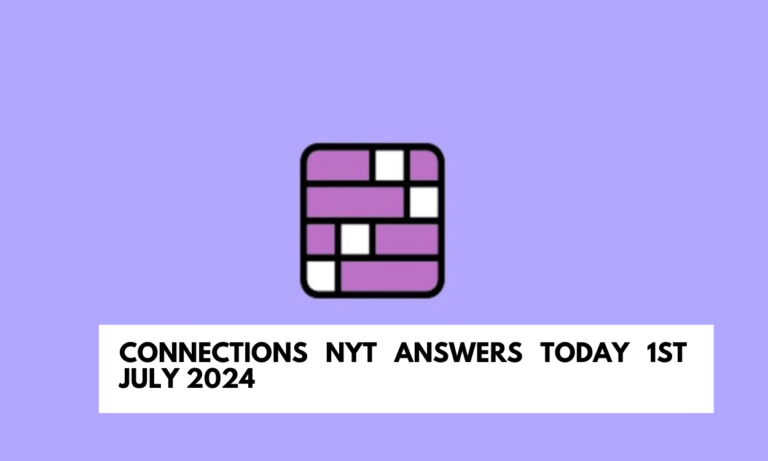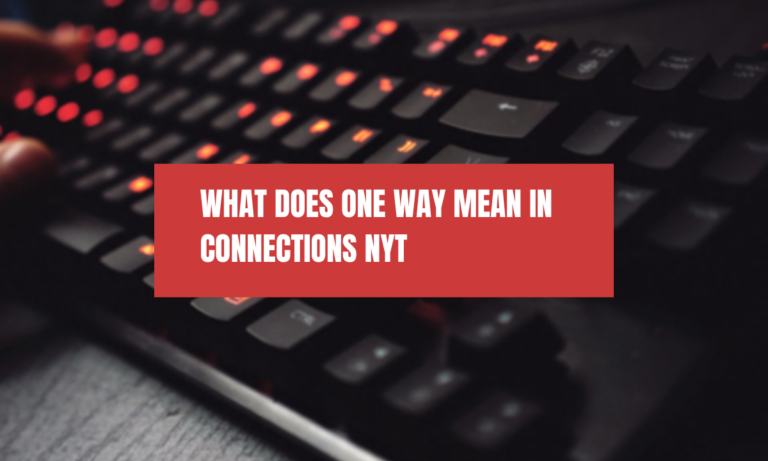Today’s NYT Connections Hint and Answers – June 21, 2024
Welcome to the ultimate guide for NYT Connections hints and answers for June 21, 2024. Whether you’re a seasoned player or new to the game, this comprehensive post will help you navigate today’s puzzle with ease. Let’s dive into the details and explore effective strategies, daily hints, and the solutions for today’s challenge.
What is NYT Connections?
NYT Connections is a popular word puzzle game from The New York Times. The objective is to identify and group words that share a common theme. With each game offering a new set of challenges, players must use their vocabulary, pattern recognition, and critical thinking skills to succeed.
The game is managed by Wyna Liu, the NYT’s associate puzzle editor, and has become a daily ritual for many word enthusiasts. As the game resets at midnight local time, players eagerly await the new puzzle to test their skills.
How to Play NYT Connections
NYT Connections is straightforward yet challenging. Here’s a step-by-step guide to help you get started:
- Overview: You are presented with 16 words.
- Objective: Group these words into four categories, each containing four words.
- Rules:
- You can make up to four incorrect guesses.
- The categories can vary widely from common themes to obscure connections.
- Hints: Each group is color-coded to help you identify potential matches.
- Completion: Successfully group all words to complete the puzzle.
Today’s NYT Connections Hints for June 21, 2024
To help you get a head start, here are the hints for today’s puzzle. Use these clues to narrow down the possible connections between the words:
- Yellow Group – Constellations: Celestial patterns named after mythological characters or animals.
- Green Group – Types of Dance: Various dance styles performed on stage or in social settings.
- Blue Group – Elements of Fiction: Components typically found in a novel or story.
- Purple Group – Types of Fabric: Different kinds of material used in clothing and upholstery.
Detailed Answers and Explanations
If the hints aren’t enough and you’re still stuck, here are the detailed answers for June 21, 2024:
- Constellations:
- ORION: A prominent constellation named after a hunter in Greek mythology.
- CYGNUS: Known as the Swan, a constellation in the northern sky.
- CASSIOPEIA: Named after a queen in Greek mythology, recognizable by its distinctive ‘W’ shape.
- PEGASUS: Named after the winged horse in Greek mythology.
- Types of Dance:
- BALLET: A classical dance form characterized by grace and precision.
- TANGO: A passionate dance that originated in Argentina.
- SALSA: A lively, rhythmic dance with roots in Latin America.
- HIP-HOP: A street dance style that evolved from hip-hop culture.
- Elements of Fiction:
- PLOT: The sequence of events in a story.
- CHARACTER: The individuals who participate in the action of a story.
- SETTING: The time and place where the story occurs.
- THEME: The underlying message or central idea of a story.
- Types of Fabric:
- COTTON: A natural fiber used in many textiles.
- WOOL: A textile fiber obtained from sheep and other animals.
- SILK: A fine, strong, soft, and shiny fiber produced by silkworms.
- DENIM: A sturdy cotton twill fabric, typically blue, used in jeans.
Strategies for Solving NYT Connections
Here are some strategies to help you tackle NYT Connections puzzles effectively:
- Skim Through All Words: Quickly glance at all 16 words to identify any obvious connections.
- Pair Words Together: Look for pairs of words that seem related and try to expand those pairs into groups of four.
- Use Process of Elimination: Confirm one or two groups to narrow down the options for the remaining words.
- Think Broadly and Specifically: Some connections may be very general, while others might be specific. Keep an open mind.
- Take Breaks: If you’re stuck, take a short break and return with a fresh perspective.
The Evolution of NYT Connections
NYT Connections has evolved significantly since its inception. Initially launched in beta, the game quickly gained popularity and became a staple in the NYT Games collection. The game’s daily puzzles and the engaging community it has built are testaments to its success.
The puzzle’s design encourages players to think creatively and make connections that are not immediately obvious. The game has also seen various updates to enhance user experience, including improved hints and the addition of new word categories.
Advanced Strategies for NYT Connections
To delve deeper into mastering NYT Connections, we need to explore some advanced strategies that can elevate your puzzle-solving skills and enhance your gaming experience. These tips go beyond the basics and are designed to help you think more critically and creatively.
1. Group Identification Techniques
Understanding how to identify groups effectively is crucial. Here are a few techniques:
- Semantic Similarity: Look for words that belong to a similar semantic field. For example, if you see words like “Mango,” “Apple,” “Banana,” and “Grape,” it’s likely that they all fall under the category of fruits.
- Functional Categories: Some words might be linked by their function rather than their meaning. For instance, “Drill,” “Hammer,” “Saw,” and “Wrench” are all tools.
- Contextual Clues: Words might be connected through a common context. “Laptop,” “Monitor,” “Keyboard,” and “Mouse” are all related to a computer setup.
2. Pattern Recognition
Pattern recognition is essential for identifying the correct groups:
- Prefixes and Suffixes: Identify common prefixes or suffixes. For example, words like “Unhappy,” “Uncertain,” “Unlikely,” and “Unfair” share the prefix “Un-.”
- Synonyms and Antonyms: Look for words that are synonyms or antonyms. “Happy,” “Joyful,” “Ecstatic,” and “Elated” are synonyms for a positive emotion.
- Phonetic Similarities: Sometimes words sound similar or rhyme, which can be a clue. “Hear,” “Here,” “Peer,” and “Cheer” all share a similar sound.
3. Mind Mapping
Creating a mind map can help visualize connections between words:
- Central Theme: Start with a central theme and branch out to related words. For example, if the central theme is “Travel,” branches could include “Airplane,” “Luggage,” “Passport,” and “Ticket.”
- Clusters: Form clusters of words that seem related. This helps in breaking down the puzzle into manageable sections.
4. Common Themes in NYT Connections
Familiarize yourself with recurring themes in NYT Connections to anticipate potential categories:
- Pop Culture: TV shows, movies, celebrities.
- Geography: Countries, cities, rivers.
- Food and Drink: Types of cuisine, beverages, ingredients.
- Nature: Animals, plants, natural phenomena.
By recognizing these common themes, you can quickly categorize words and reduce the number of incorrect guesses.
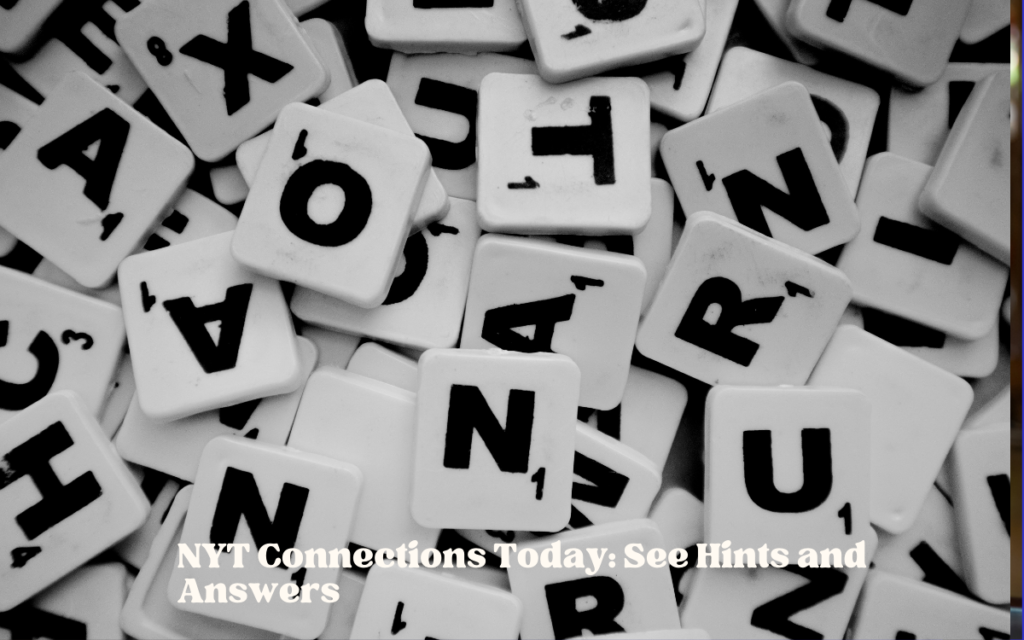
The Community and Social Aspect
NYT Connections has fostered a vibrant community of enthusiasts who share strategies, hints, and solutions. Engaging with this community can enhance your gameplay:
1. Online Forums and Groups
Join online forums and social media groups dedicated to NYT Connections. Platforms like Reddit, Facebook, and Discord have active communities where players discuss daily puzzles, share tips, and help each other out.
2. Daily Challenges and Competitions
Participate in daily challenges and competitions within the community. These events not only add a competitive edge but also provide opportunities to learn from other skilled players.
3. Sharing and Collaboration
Collaborate with friends or family members to solve puzzles. Sometimes a fresh perspective can make a significant difference. Sharing your thought process can also help others improve their skills.
Historical Context and Evolution of Word Puzzles
Understanding the history and evolution of word puzzles can provide insights into their complexity and appeal. Word puzzles have been around for centuries, evolving from simple riddles to complex games like NYT Connections.
1. Ancient Origins
Word puzzles date back to ancient civilizations. The Greeks and Romans enjoyed word games, and examples of these have been found in historical texts. Riddles and anagrams were popular forms of entertainment and intellectual exercise.
2. Modern Word Puzzles
The modern era of word puzzles began in the 19th and 20th centuries with the rise of newspapers and magazines. The first known crossword puzzle was published in 1913 by Arthur Wynne in the New York World. This sparked a revolution in puzzle games, leading to the creation of various other forms like word searches, anagrams, and cryptograms.
3. Digital Transformation
With the advent of digital technology, word puzzles have transformed significantly. Online platforms and mobile apps have made these games more accessible. NYT Connections is a prime example of a digital word puzzle that leverages technology to offer daily challenges and engage a global audience.
Benefits of Daily Puzzle Solving
Engaging in daily puzzle-solving activities like NYT Connections offers numerous cognitive and psychological benefits:
1. Cognitive Enhancement
Regularly solving word puzzles can improve cognitive functions such as memory, attention, and problem-solving skills. It stimulates different areas of the brain, enhancing overall mental agility.
2. Stress Relief
Word puzzles provide a form of mental escapism. Focusing on a puzzle can divert attention from stressors and provide a sense of accomplishment upon completion.
3. Social Interaction
Participating in puzzle-solving communities fosters social interaction and a sense of belonging. Sharing tips, competing, and collaborating with others can enhance social bonds and create a supportive network.
Conclusion
NYT Connections is not just a game but a daily intellectual exercise that offers numerous benefits. By understanding the strategies for solving puzzles, engaging with the community, and appreciating the historical context of word puzzles, you can enhance your gameplay and enjoy the process even more.
Whether you’re looking to improve your cognitive skills, reduce stress, or simply enjoy a fun and challenging activity, NYT Connections provides the perfect platform. Keep practicing, stay engaged with the community, and most importantly, have fun solving the puzzles!
For more detailed guides and past puzzle answers, you can visit sites like Try Hard Guides and Beebom which offer extensive coverage on NYT Connections and other popular word games.
FAQs
What is NYT Connections?
NYT Connections is a word puzzle game by The New York Times where players group 16 words into four categories based on a common theme. Each category contains four words.
How do I play NYT Connections?
You are given 16 words and must group them into four categories with four words each. You can make up to four incorrect guesses before the game ends. The categories vary daily and are based on common themes.
What are the hints for NYT Connections on June 21, 2024?
Yellow Group – Constellations
Green Group – Types of Dance
Blue Group – Elements of Fiction
Purple Group – Types of Fabric
What are the answers for NYT Connections on June 21, 2024?
Constellations: ORION, CYGNUS, CASSIOPEIA, PEGASUS
Types of Dance: BALLET, TANGO, SALSA, HIP-HOP
Elements of Fiction: PLOT, CHARACTER, SETTING, THEME
Types of Fabric: COTTON, WOOL, SILK, DENIM
Can I play past NYT Connections puzzles?
No, each day’s puzzle is unique and can only be played on that day. However, you can find past answers and hints on websites like Try Hard Guides and Beebom
What are the benefits of playing NYT Connections?
Benefits include enhancing vocabulary, boosting cognitive function, reducing stress, and improving pattern recognition.

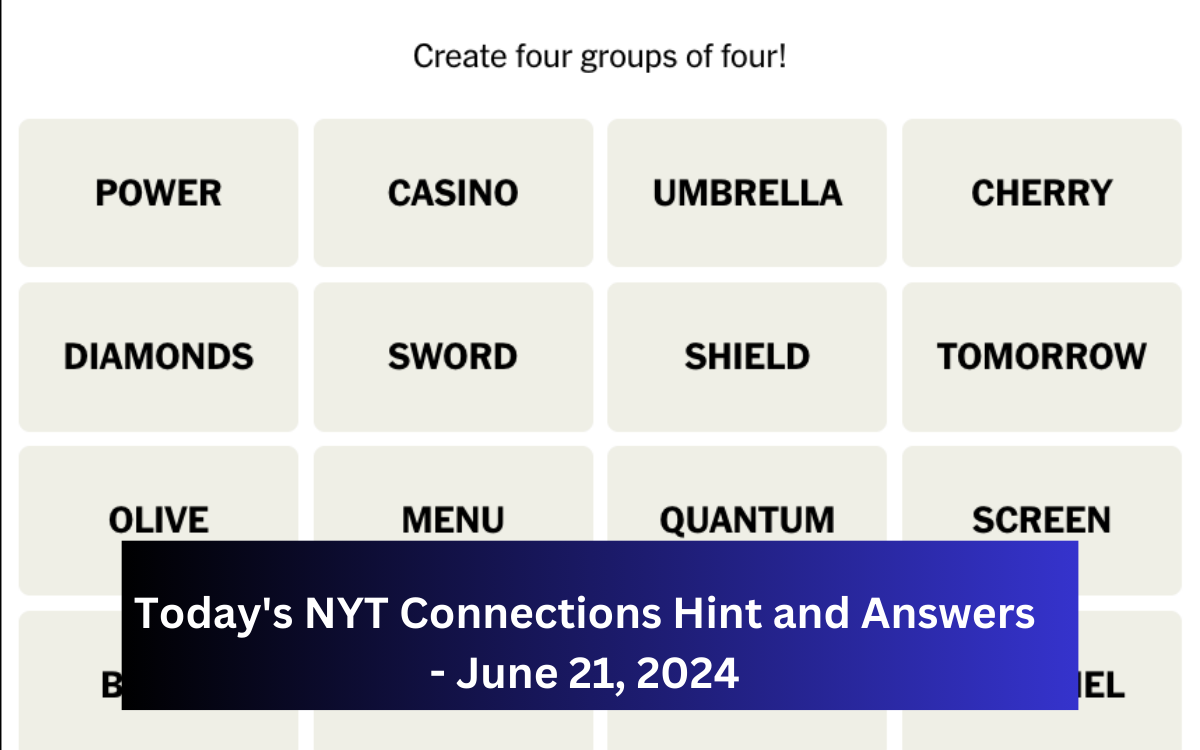

![How to Play Connections Game Easy Mode [2024]](https://connectionsnyt.pro/wp-content/uploads/2024/06/Connections-NYT-Ranked-Best-Educational-Game-For-2024-28-768x480.png)

